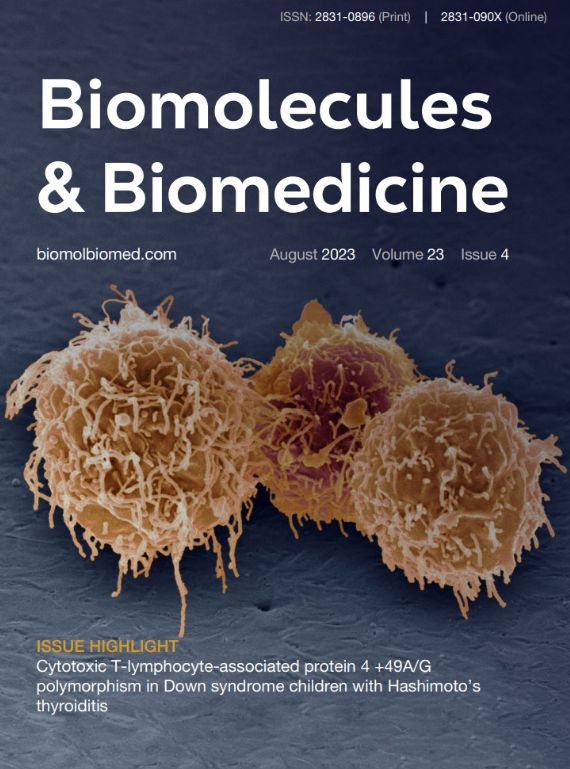Vol.23 No.2
Published: 11.07.2023.
Authors in this issue:
Abdella M Habib, Abdul-Badi Abou-Samra, Aleksandra Aracki Trenkić, Angela Pia Cazzolla, Atalla Hammouda, Benjie Xu, Boris Zec, Cheng Rao, Chenwei Li, Chunyue Feng, Dan Li, Dejan Nesic, Domenico Ciavarella, Dominik Vilímek, Dragan Stojanov, Eleonora Lo Muzio, Elina Beleva, Fang Li, Fei Liu, Feng Wang, Francesca Di Serio, Francesca Spirito, Gaofei Cao, Gordana Petrovic, Haibo Lu, Hao Jiang, Haowen Pang, Hongbing Ma, Hua Yang, Ivanka Nenova, Jan Malůš, Jaroslav Uchytil, Jianguang Shi, Jiayue Shao, Jie Gong, Jie Lian, Jieqiu Zhang, Jieyun Huang, Jin Li, Jun Wang, Justin Clark, Kai Sun, Lichun Wei, Lina Zhao, Ling-Yu Long, Lishuang Wang, Liu Shi, Lorenzo Lo Muzio, Lucia Varraso, Luigi Santacroce, Luka Nikolic, Marek Bužga, Maria Pepe, Mario Dioguardi, Matej Pekař, Mei Shi, Mengyao Zhang, Michele Di Cosola, Milica Radovanović, Milica Živanović, Miroslav Mišić, Mohan Dong, Moustapha Hamdi, Nan Xu, Omran A H Musa, Pavol Holéczy, Petr Kutáč, Qian Jiang, Qian Zhang, Qiong Qing, Quan-Bing Zhang, Ren Wang, Renato Contino, Roberto Lovero, Rui Zhang, Run Zhang, Saif Badran, Sanja Ninic, Sara Alharami, Sasa Popovic, Semir Vranic, Sergej Prijic, Shigao Huang, Shuli Tang, Siqi Liu, Snezana Ristic, Snezhana Stoencheva, Srdjan Pasic, Stasa Krasic, Suhail A Doi, Tanya Deneva, Veronika Horká, Vito Crincoli, Vladislav Vukomanovic, Vuk Milošević, Vukota Radovanović, Weijie Wu, Weiwei Li, Wen-Min Chen, Wudong Wang, Xiangyi Pang, Xiao-Jun Huang, Xiaopeng Yao, Xiaoxiao Liu, Xin Wang, Xinjian Li, Xu Wang, Xuejing Zhong, Ya-Zhen Qin, Yanhui Chen, Ying Zhang, Yingying Jin, Yongrong Zhang, Yuchen Wang, Yun Zhou, Zdeněk Švagera, Zhanet Grudeva-Popova, Zhenjing Jin, Zishan Wang,
Edited by:
Muzafer Mujic & Semir Vranic
Author guidelines
Editorial Policy
4
Issues23
ArticlesYour first address
𝐁𝐢𝐨𝐦𝐨𝐥𝐞𝐜𝐮𝐥𝐞𝐬 𝐚𝐧𝐝 𝐁𝐢𝐨𝐦𝐞𝐝𝐢𝐜𝐢𝐧𝐞 (formerly 𝐁𝐉𝐁𝐌𝐒) is the first address for discoveries in the field of biomedical research.
Become guest editor
Special Issues are led by Guest Editors who are experts in the subject and oversee the editorial process for papers.
Editor’s choice articles
The aim is to provide a snapshot of some of the most exciting work published in the various research areas of the journal.
Archive
See all
Volume 23, Issue 2, 2023
Volume 23, Issue 2, 2023
Volume 15, Issue 1,
Volume 14, Issue 1,
- All Sections
- Biochemistry
- Molecular Biology
- Pathology
- Anatomy
- Translational and Clinical Research
- New and Emerging Medical Entities
16.03.2023.
Editorial
Sacituzumab govitecan expands its therapeutic spectrum among breast cancer subtypes
Semir Vranic
16.03.2023.
Research article
Prevention of sarcopenia in patients with obesity after bariatric and metabolic surgery: The effect of programmed training on the muscle tissue and anthropometric functions—A randomized controlled trial (SarxOb study protocol)
Marek Bužga, Matej Pekař, Jaroslav Uchytil, Veronika Horká, Jan Malůš, Dominik Vilímek, Zdeněk Švagera, Petr Kutáč, Pavol Holéczy
16.03.2023.
Research article
Intrinsic resistance and efficacy of immunotherapy in microsatellite instability-high colorectal cancer: A systematic review and meta-analysis
Some patients with microsatellite instability-high colorectal cancer (MSI-H CRC) have shown a poor response to immunotherapy in clinical trials. We investigated the intrinsic resistance to and efficacy of immunotherapy in patients with MSI-H CRC. The PubMed and Web of Science databases were searched using keywords such as “colorectal cancer,” “immunotherapy,” and “clinical experiment.” Random-effects models were used to generate the combined complete response, partial response, stable disease, progressive disease, objective response rate (ORR), disease control rate (DCR), and incidence of adverse events. We then performed a subgroup analysis based on the ORR and incidence of intrinsic resistance. The meta-analysis included seven clinical trials. The incidences of complete response, partial response, stable disease, and progressive disease summarized by the random-effects model were 8%, 37%, 26%, and 25%, respectively. The ORR and DCR were 45% and 71%, respectively. The ORRs of programmed cell death protein 1 inhibitor (anti-PD-1), programmed death ligand 1 inhibitor (anti-PD-L1), and anti-PD-1 combined with cytotoxic T lymphocyte-associated antigen 4 inhibitor (anti-CTLA-4) immunotherapy were 38%, 54%, and 57%, respectively. The ORR of immune checkpoint inhibitors for first- and third-line therapy was 56% and 32%, respectively. Dual-drug immunotherapy significantly reduced the incidence of intrinsic resistance to immunotherapy (12% vs 31%). The incidences of intrinsic resistance to first-line therapy and second-line and later therapy were 29% and 26%, respectively. Approximately 25% of patients with MSI-H CRC had intrinsic resistance to immunotherapy. Anti-PD-1 combined with anti-CTLA-4 significantly increased the ORR, thereby reducing the incidence of intrinsic resistance. Moving immunotherapy into earlier lines of therapy, although not reducing the incidence of intrinsic resistance, can improve the ORR in patients with MSI-H CRC.
Ren Wang, Jie Lian, Xin Wang, Xiangyi Pang, Benjie Xu, Shuli Tang, Jiayue Shao, Haibo Lu
16.03.2023.
Research article
The role of magnetic resonance imaging in the diagnosis and prognosis of dementia
Dementia is a syndrome characterized by multidomain acquired chronic cognitive impairment that has a profound impact on daily life. Neurogenerative diseases such as Alzheimer’s disease or nondegenerative diseases such as vascular dementia are considered to cause dementia. The need for further diagnostic improvement originates from the prevalence of these conditions, especially in developed countries with a predominance of the elderly population. Today, the diagnosis and follow-up of all neurodegenerative diseases cannot be performed without radiological imaging, primarily magnetic resonance imaging (MRI). The introduction of 3T MRI and its modern techniques, such as arterial spin labeling, has enabled better visualization of morphologic changes in dementia. For better diagnosis and follow-up in patients with dementia, various semiquantitative scales have been designed to improve the accuracy of assessment and decrease interobserver variability. Moreover, there is a growing need for MRI in the assessment of novel therapies and their side effects. To better apply MRI findings in the diagnosis of both already developed dementia and its early stages, the aim of this paper is to review the available literature and summarize the specific MRI changes.
Milica Živanović, Aleksandra Aracki Trenkić, Vuk Milošević, Dragan Stojanov, Miroslav Mišić, Milica Radovanović, Vukota Radovanović
16.03.2023.
Research article
Artificial intelligence in renal pathology: Current status and future
Renal biopsy pathology is an essential gold standard for the diagnosis of most kidney diseases. With the increase in the incidence rate of kidney diseases, the lack of renal pathologists, and an imbalance in their distribution, there is an urgent need for a new renal pathological diagnosis model. Advances in artificial intelligence (AI) along with the growing digitization of pathology slides for diagnosis are promising approach to meet the demand for more accurate detection, classification, and prediction of the outcome of renal pathology. AI has contributed substantially to a variety of clinical applications, including renal pathology. Deep learning, a subfield of AI that is highly flexible and supports automatic feature extraction, is increasingly being used in multiple areas of pathology. In this narrative review, we first provide a general description of AI methods, and then discuss the current and prospective applications of AI in the field of renal pathology. Both diagnostic and predictive prognostic applications are covered, emphasizing AI in renal pathology images, predictive models, and 3D in renal pathology. Finally, we outline the challenges associated with the implementation of AI platforms in renal pathology and provide our perspective on how these platforms might change in this field.
Chunyue Feng, Fei Liu
16.03.2023.
Research article
Metabolic aspects of surgical subcutaneous fat removal: An umbrella review and implications for future research
Although obesity is a preventable disease, maintaining a normal body weight can be very challenging and difficult, which has led to a significant increase in the demand for surgical subcutaneous fat removal (SSFR) to improve physical appearance. The need for SSFR is further exacerbated because of the global rise in the number of bariatric surgeries, which is currently the single most durable intervention for mitigating obesity. Fat tissue is now recognized as a vital endocrine organ that produces several bioactive proteins. Thus, SSFR-mediated weight (fat) loss can potentially have significant metabolic effects; however, currently, there is no consensus on this issue. This review focuses on the metabolic sequelae after SSFR interventions for dealing with cosmetic body appearance. Data were extracted from existing systematic reviews and the diversity of possible metabolic changes after SSFR are reported along with gaps in the knowledge and future directions for research and practice. We conclude that there is a potential for metabolic sequelae after SSFR interventions and their clinical implications for the safety of the procedures as well as for our understanding of subcutaneous adipose tissue biology and insulin resistance are discussed.
Saif Badran, Suhail A Doi, Moustapha Hamdi, Atalla Hammouda, Sara Alharami, Justin Clark, Omran A H Musa, Abdul-Badi Abou-Samra, Abdella M Habib
16.03.2023.
Research article
Reduced circulating interleukin 35 is associated with enhanced peripheral T cell function in primary biliary cholangitis
Interleukin 35 (IL-35) mediates immunosuppression of T cells in autoimmune diseases. T cells play an important role in primary biliary cholangitis (PBC) with incompletely elucidated pathogenesis. Thus, we aimed to investigate the role of IL-35 regulation on T cells in PBC patients. Fifty-one PBC patients and 28 controls were enrolled in this study. Plasma IL-35 level was measured. Purified peripheral CD4+ and CD8+ T cells were stimulated with exogenous IL-35 to investigate their functional phenotypes. IL-35-treated CD8+ T cells were cultured with human intrahepatic biliary epithelial cell line to determine the cytotoxicity of CD8+ T cells from PBC patients. Plasma IL-35 concentration was lower in PBC patients and negatively correlated with alkaline phosphatase. CD4+ T cells from PBC patients exhibited elevated transcription factor expressions and cytokine secretion, whereas CD8+ T cells produced increased cytotoxic molecules and cytokines. In vitro IL-35 stimulation suppressed the production of IL-17 and IL-22 by CD4+ T cells from PBC patients. CD8+ T cells treated with IL-35 mediated reduced target cell death in the direct contact co-culture system in PBC patients. This process was accompanied by reduced production of cytotoxic molecules and cytokines and increased expressions of immune checkpoint receptors in CD8+ T cells. Reduced circulating IL-35 might be insufficient to suppress T cell function, leading to the immune dysregulation in PBC patients.
Siqi Liu, Qian Zhang, Mengyao Zhang, Xuejing Zhong, Wudong Wang, Lishuang Wang, Zhenjing Jin
16.03.2023.
Research article
Deletion of sphingosine kinase 2 attenuates cigarette smoke-mediated chronic obstructive pulmonary disease-like symptoms by reducing lung inflammation
Yanhui Chen, Yongrong Zhang, Cheng Rao, Jieyun Huang, Qiong Qing
16.03.2023.
Research article
Effect of vascular endothelial growth factor rs35569394 in esophageal cancer and response to chemotherapy
Zishan Wang, Chenwei Li, Xinjian Li, Jianguang Shi, Weijie Wu
16.03.2023.
Research article
Possible mechanism of static progressive stretching combined with extracorporeal shock wave therapy in reducing knee joint contracture in rats based on MAPK/ERK pathway
The study aimed to observe the therapeutic effect of static progressive stretching (SPS) combined with extracorporeal shock wave therapy (ESWT) on extension knee joint contracture in rats and the effect on the mitogen-activated protein kinase (MAPK)/extracellular signal-regulated kinase (ERK) pathway in the development of joint capsule fibrosis. Thirty-six Sprague Dawley rats were randomly divided into blank control group, immobilization model group, natural recovery group, ESWT intervention group, SPS intervention group, and SPS combined with ESWT intervention group. The left knee joints of the rats, except for the control group, were fixed with an external fixation brace for four weeks at full extension to form joint contracture. The therapeutic effect of each intervention was assessed by evaluating total and arthrogenic contracture, the number of total cells and collagen deposition in the anterior joint capsule, the protein levels of TGF-β1, FGF-2, and ERK2 in the anterior joint capsule, the mean optical density of upstream RAS and downstream ERK2 positive expression in the MAPK/ERK pathway. SPS in combination with ESWT was more effective in relieving joint contracture, improving the histopathological changes in the anterior joint capsule, and suppressing the high expression of target proteins and the overactivated MAPK/ERK pathway. The overactivated MAPK/ERK pathway was involved in the formation of extension knee joint contracture in rats. SPS in combination with ESWT was effective in relieving joint contracture and fibrosis of joint capsule. Moreover, the inhibition of the overactivated MAPK/ERK pathway may be the potential molecular mechanism for its therapeutic effect.
Run Zhang, Quan-Bing Zhang, Yun Zhou, Rui Zhang, Feng Wang
16.03.2023.
Research article
Assessment of clinical utility and predictive potential of pre-chemotherapy soluble urokinase plasminogen activator receptor: Observational single center study
Elina Beleva, Snezhana Stoencheva, Tanya Deneva, Ivanka Nenova, Zhanet Grudeva-Popova
16.03.2023.
Research article
Clinical features and outcomes of fusion gene defined adult Ph-negative B-cell precursor acute lymphoblastic leukemia patients: A single institutional report
Kai Sun, Jun Wang, Wen-Min Chen, Nan Xu, Ling-Yu Long, Xu Wang, Hao Jiang, Qian Jiang, Xiao-Jun Huang, Ya-Zhen Qin
16.03.2023.
Research article
Efficacy and safety of PEG-rhG-CSF in preventing chemoradiotherapy-induced neutropenia in patients with locally advanced cervical cancer
Weiwei Li, Mohan Dong, Shigao Huang, Liu Shi, Hua Yang, Ying Zhang, Jie Gong, Mei Shi, Lichun Wei, Lina Zhao
16.03.2023.
Research article
Development and validation of radiomics machine learning model based on contrast-enhanced computed tomography to predict axillary lymph node metastasis in breast cancer
Jieqiu Zhang, Gaofei Cao, Haowen Pang, Jin Li, Xiaopeng Yao
16.03.2023.
Research article
Intensity-modulated radiation therapy for elderly patients with esophageal cancer: Our experience
Dan Li, Xiaoxiao Liu, Yuchen Wang, Yingying Jin, Fang Li, Hongbing Ma
16.03.2023.
Research article
Analysis of cardiac manifestation and treatment of multisystem inflammatory syndrome in children related to SARS-CoV-2
Cardiovascular (CV) manifestations are common (35%–100%) in the multisystem inflammatory syndrome in children. Our study aimed to analyze treatment impact and CV involvement in patients with multisystem inflammatory syndrome in children. The retrospective cohort included 81 patients treated between April 2020 and December 2021 (9.3 ± 4.6 years). Elevated cardiac troponin I and pro-B-type natriuretic peptide were observed in 34.2% and 88.5% of patients, respectively. Myocardial dysfunction was observed in 50.6%. Children older than 10 years had a 4-fold increased risk of myocardial dysfunction (odds ratio [OR] 3.6, 95% confidence interval [CI] 1.4–8.9; p ═ 0.006). A moderate negative correlation was proved between left ventricular ejection fraction and C-reactive protein (rr ═ −0.48; p < 0.001). More than one-fifth of the patients presented with shock. Coronary artery dilatation was observed in 6.2% of patients. Mild pericardial effusion was detected in 27.1% of children. On standard electrocardiogram, 52.6% of children had negative T waves in the inferior and/or precordial leads; transient QTc prolongation was registered in 43% of patients. Treatment failure was observed in 19 patients. Patients initially treated with intravenous immunoglobulins had 10-fold higher chances for treatment failure than patients treated with corticosteroids (OR 10.6, 95% CI 3.18–35.35; p < 0.001). CV manifestations were observed in more than half of the patients, with acute myocardial dysfunction being the most common, especially in children older than 10 years. We established a negative association between the degree of elevation of inflammatory markers and left ventricular ejection fraction. Patients treated with intravenous immunoglobulins who had CV manifestations had treatment failures more frequently than patients treated with corticosteroids.
Stasa Krasic, Sanja Ninic, Sergej Prijic, Sasa Popovic, Srdjan Pasic, Gordana Petrovic, Boris Zec, Snezana Ristic, Dejan Nesic, Luka Nikolic, Vladislav Vukomanovic
16.03.2023.
Research article
Evaluation of qualitative and quantitative taste alterations in COVID-19
Angela Pia Cazzolla, Roberto Lovero, Francesca Spirito, Michele Di Cosola, Luigi Santacroce, Eleonora Lo Muzio, Domenico Ciavarella, Mario Dioguardi, Vito Crincoli, Maria Pepe, Lucia Varraso, Renato Contino, Francesca Di Serio, Lorenzo Lo Muzio











